

The Most Dangerous Phrase In Education. The Most Dangerous Phrase In Education by Terry Heick I was speaking (tweeting) with Mark Barnes tonight, and he mentioned the idea of challenging existing forms and practices.
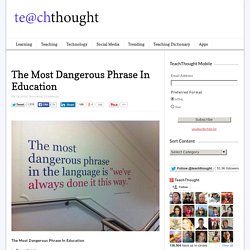
And then someone tweeted the above image–a quote attributed to Rear Admiral Grace Hopper, according to the image source globalnerdy.com–and I was happy and favorited and saved and blogged. The most dangerous phrase in the language is “we’ve always done it this way.” Which applies to education, too. I talk a lot about disruptive teaching and paradigm shifting in teaching and learning not because I’m inherently rebellious, or some kind of academic anarchist. It’s not bad, it just doesn’t reflect the priority and urgency of our collective challenge. Changing lives usually comes from relationships with teachers rather than the power of curriculum. The problem with the safe approach to teaching is that it won’t yield anything other than what we’ve always had.
How Digital Platforms Are Disrupting How Learning Happens. Media is becoming increasingly digitized, and we learn through, among other processes, consumption of media.
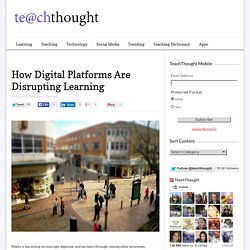
It makes sense then that digital platforms just might be changing the way learning happens. A “platform” can be defined as an app, a website, an eLearning environment, or a collaboratively curated content source. 6 Examples Of Digital Platforms 1. Apps: Phonics Genius, Frog Dissection, Google Earth 2. Virtual Reality is the Future of Career Education. Every so often, a new way emerges.
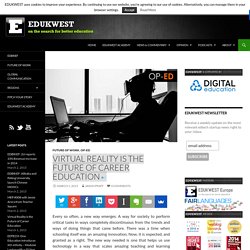
A way for society to perform critical tasks in ways completely discontinuous from the trends and ways of doing things that came before. There was a time when schooling itself was an amazing innovation. Now, it is expected, and granted as a right. The new way needed is one that helps us use technology in a way that scales amazing teaching and learning experiences. Experiences that heighten learning and enrich lives, and are delivered in efficient and cost effective ways. But I am not convinced most schools see it that way. It is in times like this that I encourage leaders across the education spectrum to repeat and believe one simple phrase, “there is a better way”. As a society, we are at the dawn of new technology, and real exponential advancement. Instead of stopping there and spending time trying to realize the available efficiency offered by the current high tech paradigm, we should view our roles as pushing ahead to take the next step. Related. How complex is learning?
15 Shareable Learning Design & Development Quotes. Here is a list of are some of the best quotes about training, success and learning.
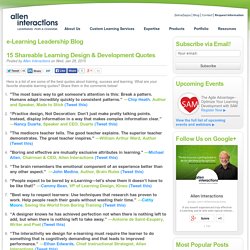
What are your favorite sharable learning quotes? Share them in the comments below! "The most basic way to get someone's attention is this: Break a pattern. Humans adapt incredibly quickly to consistent patterns.” ―Chip Heath, Author and Speaker, Made to Stick (Tweet this)“Practice design, Not Decoration: Don’t just make pretty talking points. Tags: e-Learning Design, Allen Interactions, Ethan Edwards, Michael Allen. The 4 Stages Of Edtech Disruption. The 4 Stages Of The Integration Of Technology In Learning by Terry Heick For professional development around this idea or others you read about on TeachThought, contact us.
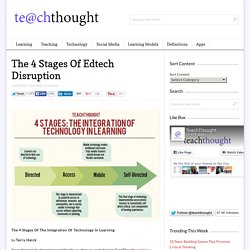
The Evolution of Classroom Technology Infographic. Educational Technology Infographics The Evolution of Classroom Technology Infographic shows how we moved from pencil and paper to iPads and online platforms.
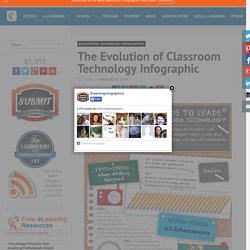
Via: www.onlineschools.com Embed This Education Infographic on your Site or Blog! Peer Learning Handbook. Crowd shaped: The future of online learning? The @chat2lrn crew are delighted to have a blog post this week from Kate Graham (@kategraham23) in which she explores Crowd Sourced Learning.
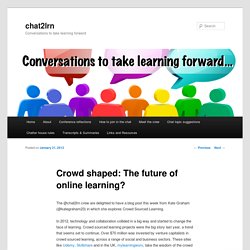
In 2012, technology and collaboration collided in a big way and started to change the face of learning. Crowd sourced learning projects were the big story last year, a trend that seems set to continue. Over $70 million was invested by venture capitalists in crowd sourced learning, across a range of social and business sectors. These sites like Udemy, Skillshare and in the UK, mylearningworx, take the wisdom of the crowd (i.e. any Internet user), validate it and share it in one easy to use place. Although quite new, these crowd sourced learning hubs are already offering learners thousands of courses. The background to this rise is the failure of the Internet search engines and social applications to deliver timely, authoritative answers to learning challenges, too often leading students down frustrating blind alleys.
The Definition Of The Flipped Classroom. The Definition Of The Flipped Classroom As one of the most popular trends in education in recent memory, you’ve undoubtedly heard of the flipped classroom.

But what is it about a classroom that’s been flipped that makes it unique? A flipped classroom is one where students are introduced to content at home, and practice working through it at school. In this blended learning approach, face-to-face interaction is mixed with independent study via technology. Students watch pre-recorded videos at home, then come to school to do the homework armed with questions and at least some background knowledge. Augmented Reality Brings New Dimensions to Learning.
Editor's Note: Drew Minock, who co-wrote this piece, is an elementary teacher, co-founder of the popular education blog Two Guys and Some IPads, and is one of the voices on "The Two Guys Show" podcast.
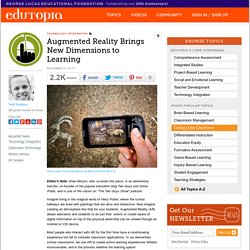
Imagine living in the magical world of Harry Potter, where the school hallways are lined with paintings that are alive and interactive. Now imagine creating an atmosphere like that for your students. Augmented Reality (AR) allows educators and students to do just that: unlock or create layers of digital information on top of the physical world that can be viewed through an Android or iOS device. Diversity or conformity? 3 things you should know about Edupunk. The future of education technology. Design Thinking in the Classroom: Free Inspiration from the Ad Award Winners. "For students, the best classroom experience is a space of possibility.

" - Anne Stevens1 Design thinking can transform your classroom into a space of creativity, excitement and possibility. The design thinking process involves rethinking and reframing problems to make things easier, more streamlined or different. Jackie Gerstein attests that design thinking is an important skill for students to learn as part of their education.2 What Is Design Thinking? Design thinking is a structured approach to solving problems.